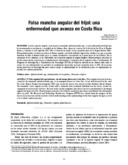| dc.contributor.author | Barrantes S., Walter | |
| dc.contributor.author | Araya F., Carlos Manuel | |
| dc.contributor.author | Esquivel H., Alejandro | |
| dc.date.accessioned | 2015-03-19T21:35:10Z | |
| dc.date.available | 2015-03-19T21:35:10Z | |
| dc.date.issued | 2006 | |
| dc.identifier | 471604 | es_ES |
| dc.identifier.issn | 1659-0082 | es_ES |
| dc.identifier.uri | https://repositorio.catie.ac.cr/handle/11554/6314 | |
| dc.description | 1 ilustraciones 8 referencias bibliográficas | es_ES |
| dc.description.abstract | La falsa mancha angular, causada por el nematodo Aphelenchoides spp., es una enfermedad del frijol que ha incrementado su incidencia y severidad en los últimos años. Apareció a inicios de la década de los 90 en la Región Brunca, y durante el ciclo agrícola 2003-2004 se observó un ataque severo en plantaciones de la Región Huetar Norte. El nematodo produce lesiones necróticas de forma angular, con borde definido, ligero halo clorótico, las que se pueden distribuir en toda la lámina foliar, pero es común encontrarlas concentradas en la parte basal de los foliolos. Por la semejanza de los síntomas, se ha confundido con la mancha angular de origen fungoso (Phaeoisariopsis griseola), lo que ha enmascarado su presencia y el productor ha subestimado el verdadero efecto negativo sobre el rendimiento. El Programa de Investigación y Transferencia de Tecnología (PITTA) de Frijol ha alertado en los últimos años sobre el avance de esta enfermedad y las perdidas de rendimiento observadas que han alcanzado hasta el 50%. Es necesario iniciar proyectos de investigación para conocer mejor la epidemiología de la enfermedad, para así implementar las medidas de combate pertinentes. | es_ES |
| dc.description.abstract | False angular leaf spot in beans, caused by the nematode Aphelenchoides spp., is an emergent disease in Costa Rica. It was first observed in the early 90s at the Brunca Region, but during the 2003 crop season the disease was detected in the Northern Huetar Region. The nematode causes angular necrotic lesions with a cholorotic halo, randomly distributed on the leaves; lesions are commonly located near the leaf base. Because of the similar symptoms, this disease has been misidentified as the fungal angular leaf spot caused by Phaeoisariopsis griseola, a fact that has masked its prevalence and distorted the detrimental effect on yield. The Research and Technology Transference Program (PITTA) has alerted about the progress of this disease in recent years and the need for a better understanding on the epidemiology of the false angular leaf spot, as well as to evaluate control measures. | en_EN |
| dc.format.mimetype | pdf | |
| dc.language.iso | es | es |
| dc.publisher | CATIE, Turrialba (Costa Rica) | es_ES |
| dc.relation.ispartof | Manejo Integrado de Plagas y Agroecología Número 78 (Agosto 2006) | |
| dc.rights.uri | https://creativecommons.org/licenses/by-nc-nd/4.0/ | |
| dc.subject | PHASEOLUS VULGARIS | es_ES |
| dc.subject | APHELENCHOIDES | es_ES |
| dc.subject | NEMATODA | es_ES |
| dc.subject | NEMATODOS DE LAS PLANTAS | es_ES |
| dc.subject | CONTROL DE NEMATODOS | es_ES |
| dc.subject | ENFERMEDADES DE LAS PLANTAS | es_ES |
| dc.subject | CONTROL DE ENFERMEDADES | es_ES |
| dc.subject | COSTA RICA | es_ES |
| dc.title | Falsa mancha angular del frijol: una enfermedad que avanza en Costa Rica | es_ES |
| dc.title.alternative | False angular leaf spot in beans: an advancing disease in Costa Rica | es_ES |
| dc.type | Artículo | es_ES |
| dc.journal.issueNumber | 78 | |
| dc.journal.pages | 91-93 | |



